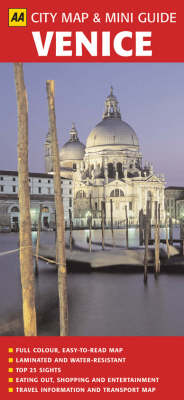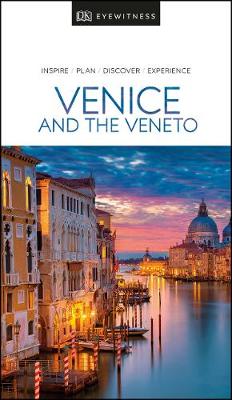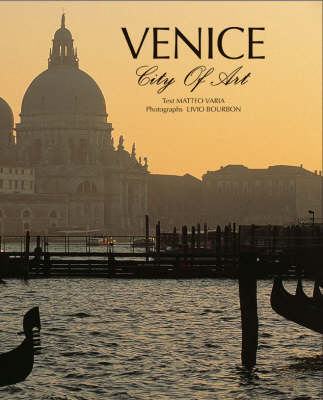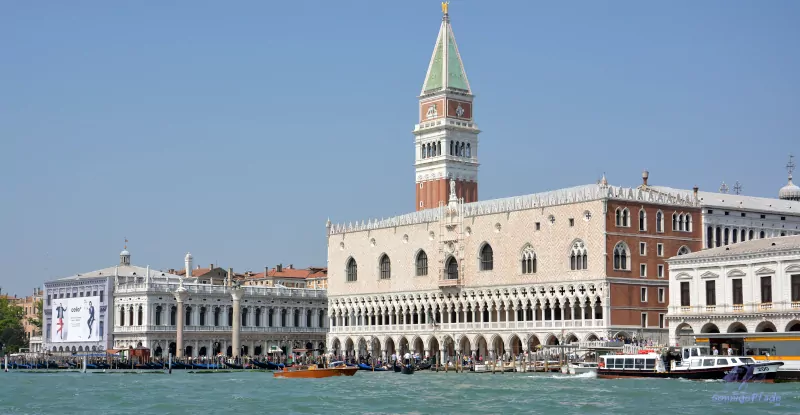
The Italian lagoon city of Venice is formed by 118 islands. About 55,000 inhabitants still live on them, the majority of the 260,000 locals are now at home in the mainland settlements of Venice. On the other hand, about 30 million tourists visit the lagoon every year.
Up and down stairs over bridges and canals in Venice
Good walking shoes are highly recommended – in no other city can you discover as much on foot as in Venice. And almost all bridges have one staircase up, one down!
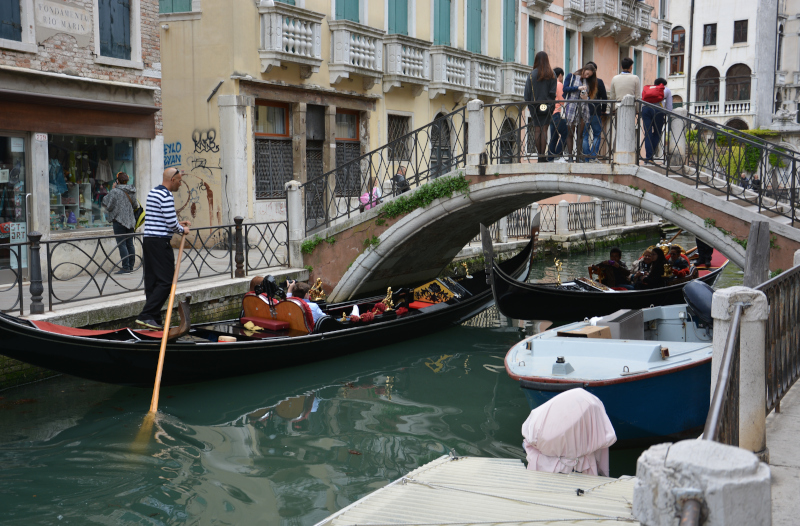
The center of Venice is divided into 6 districts. The Grand Canal winds through the center like a left-handed S and separates the northern islands of Cannaregio, Dastello and San Marco from the southern ones of Santa Croce, San Polo and Dorsoduro. Separated by the Canal della Giudecca, the Giudecca district still lies to the south. All other districts are scattered and further away in the lagoon.
First „across“ – Venice’s most important routes
For a rough orientation, it can be quite helpful if you „cross“ from Piazzale Roma (bus station) or Santa Lucia station to St. Mark’s Square – then you have a first overview of the center. To do this, you can cross the Grand Canal once – and it’s already exciting. The Grand Canal has only 4 bridges: one at Piazzale Roma towards the train station „Ponte della Costituzione“, one north-east of the train station „Ponte d Scalzi“, the famous „Rialto“ bridge and „Ponte dell Academia“. The most convenient for the aforementioned first task is probably the Rialto bridge. Otherwise, there are a few ferries at various points or the vaporetto boats, whose stops are sometimes on one side of the Grand Canal, sometimes on the other.
But as I said, this maze of alleys, squares, bridges and canals makes the charm of the city!
Otherwise, Venice offers a tremendous variety of everything: from restaurant lovers to art and culture freaks to science enthusiasts, shopping maniacs, history and architecture buffs to nature lovers and ornithology enthusiasts. In the lagoon city of Venice, just about everyone can find their niche.
St. Mark’s Square and Rialto – Bridge
Of course, walking across the Rialto Bridge is as much a part of Venice as riding under it, at least by vaporetto. In addition, a visit to the Marcus Square is quasi mandatory. There you can visit the Cathedral of San Marco (Basilica de San Marco). If you like and don’t mind the queue, you can extend this tour by climbing the „Campanile„, the free-standing bell tower of the cathedral.
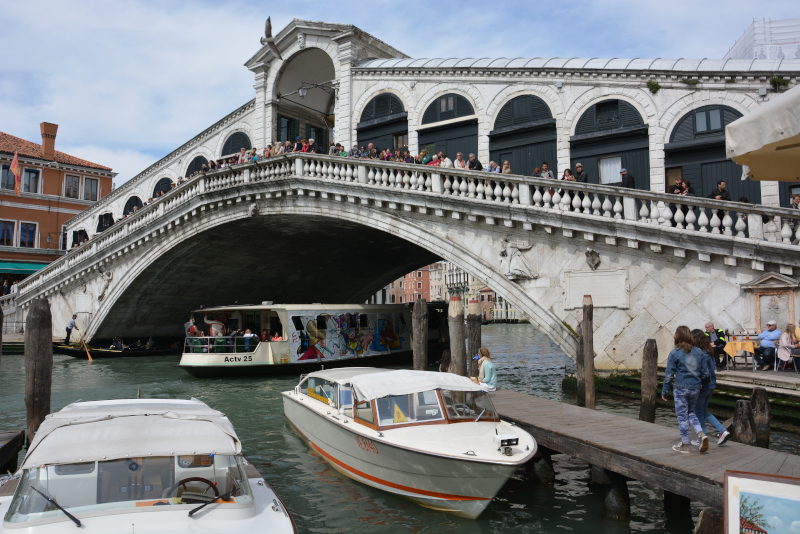
Tip for the best views of the Marcus – Square
Tip: But I’ll tell you an alternative, which is even better: Once across the Canal de San Marco – opposite is the church San Giorgio Maggiore. There is much less crowding and from the associated tower you have a great view over the main islands of Venice, directly on the Doge’s Palace, the Marcus Square and in good afternoon sun even over Venice away to the nearby Alps! Behind this cathedral is a quiet garden and in it the Teatro Verde (The Green Theater), so places to relax…
Doge’s Palace and Bridge of Sighs
Back to Marcus Square – just around the corner is the Doge’s Palace. The old center of Venetian power. Right next to it – separated by a narrow channel, the prison. And this explains the name of the bridge above it – the Bridge of Sighs. Because in the Doge’s Palace justice was also dispensed, prisoners could be led over this bridge directly from the prison to the courtrooms. And sentences were then carried out in Marcus Square – between the two columns on the Piazzetta, symbolizing the power of the Doges. Supposedly, this is why even today no real Venetian walks between the columns.
I can definitely recommend you to visit the Doge’s Palace with the prison, i.e. the way over the Bridge of Sighs is included. After all, it was from here that an empire was directed that encompassed the entire Adriatic region and had political and economic effects on all of southern and central Europe.
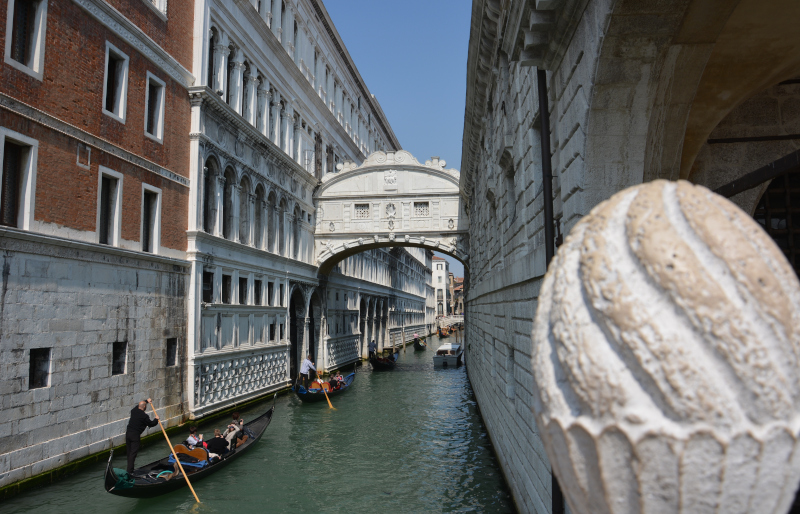
Art and culture in Venice
For art lovers of at least some directions, Venice is a paradise. The wealth of the Doges and merchant families and the broad sense of art, as well as the long trade journeys, have led to the arrival in the city of works of art from all over the world, and artists have always settled here to produce commissioned works. But not only old masters are present in Venice. The Peggy Guggenheim Collection is home to one of the most important centers of modern art in the world. The American millionaire resided in the unfinished Palazzo Ventier de Leoni and indulged her passion for collecting there until her death in 1979.
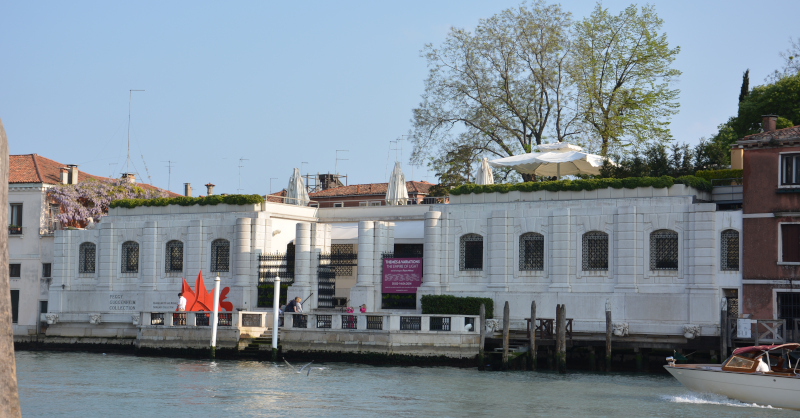
Excursions in Venice’s districts
The vaporetti of lines 4 and 5 run circular routes. The lines are marked with .1 and .2 – this is the same course, only once in one direction and once in the other. So if your legs hurt from walking in the city, you can take the public vaporetti – boats for city tours on different routes. While the center of Venice with the districts of Cannaregio, Santa Croce, Dorsoduro, San Polo, San Marco and Castello is compact and can be explored on foot, with some bridges providing connections, other districts of Venice are located in the lagoon on other islands and can only be reached by boat.
The 4-way round trip of the Vaporetti lines (4.1, 4.2) also includes the glassblowing district of Murano, while the 5-way trip (5.1, 5.2) makes a detour to the Lido, the „lagoon boundary beach“ at the Adriatic sea. Especially the following excursion you should definitely take advantage of!
Glassblowers in Venice’s Murano district

Murano is famous for its glass art. This part of the city north of the center is accessible mainly by vaporetto lines 3 and 4. Lines 12 and 13 leave only from the Fondamente Nove stop (or from the other direction from the two stops on the Lido di Jesolo peninsula, if you have your accommodation there). If you are interested in this ancient craft, an extra day in Murano is definitely worth it.
At the end of the 13th century, the glassblowers were expelled from Venice because of the high risk of fire and were confined to the island of Murano. The city fathers were probably also concerned with the control and monopolization of knowledge, because the glassblowers were forbidden to leave the island under penalty of death. Many of the glassworks can be visited, guided tours are recommended. The church of Santi Maria e Donato in Murano is one of the oldest in the lagoon, whose foundation can be traced back to the 7th century.
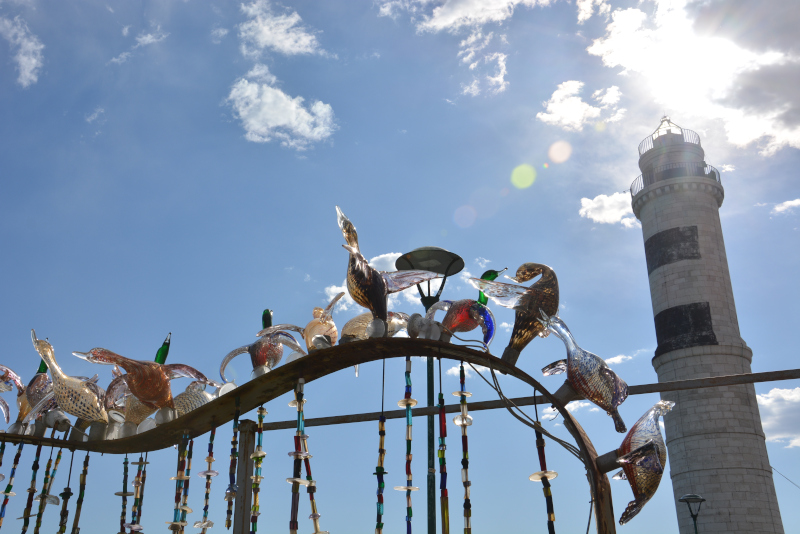
Lace maker on Burano
Another famous craft is associated with the island of Burano – lace-making. However, this skill is still spread in Burano only in the lace school Scuola dei Merletti. Burano itself is a fishing village in the lagoon with colorful houses in narrow alleys. From the Fondamente Nove stop you can reach Burano by line 12, which takes up to 1 hr. The vaporetto line 12 continues to the offshore island at Lido di Jesolo with Treporto and (partly) Punta Sabbioni.
Bathing at the Lido
With a vaporetto of line 5 or 6 you get to the Lido – one of the offshore beach islands of Venice, which separate the lagoon from the Adriatic Sea. There you can get some air, especially on hot days or after the crowds of tourists in the old town. And especially for children a real bathing pleasure, which is otherwise in the water-rich city of Venice rather not.
Why actually „Venice lagoon city“?
A lagoon is an area of a sea, in the case of Venice the Adriatic Sea, largely separated from a spit (headland) or reef. In the case of the headlands that separate the Venice Lagoon from the Adriatic Sea, the Italian term for them is „lido“. Due to the low exchange of water and often inflows of fresh water, the water of the lagoon is a „mixed water“ and is called brackish water. The old city of Venice is located on several islands in the lagoon and is therefore often called „lagoon city“.
[*contains advertisement]
Venice – Travel tips
To travel to Venice is not too difficult, especially on a trip through Europe. You can easily organize it yourself. Above all, there are various options from central Europe – whether your own car, train or long-distance bus – for long-distance travel enthusiasts, all have their charm. Already the varied stops and regions on the way make this trip an experience.
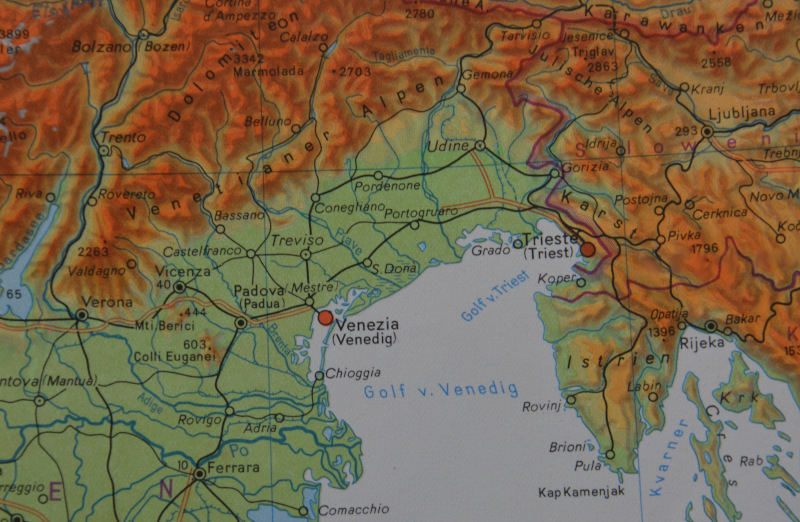
Arrival in the Lagoon city Venice
Arriving in Venice by plane
Well, flying is not recommended on short routes for climate protection reasons. But you can still, Venice has – outside the lagoon on the mainland – its own Venice airport „Marco Polo“ (IATA code VCE). Both premium airlines and low-cost airlines such as easyjet* fly to it regularly from all over Europe. Direkt from US east coast you can check Iberia airlines* via Madrid in Spain.
Marco Polo Venice airport is connected to the lagoon city by city buses (aerobus – 8€), airport shuttle buses, a vaporetto „city boat line“ and water cabs (about 120€).
Some of the budget airlines within Europa land in Treviso, which also serves as an alternate airport for „Marco Polo“ in foggy weather. (With bus shuttle).
Getting to Venice by bus and train
A more convenient way to get to Venice within Europa is by long-distance bus, train, or a combination of bus and train. The train goes to the terminus station Venice Santa Lucia. Directly in front of the station you will find the Grand Canal, so you are already „in the middle“. If your accommodation is not on the island, the mainland station Mestre may be a better destination. For most connections from central Europe a change in Verona is necessary.
You can search and book long-distance buses as well as European train connections to Venice online via the portal omio*. Omio offers ticket service for trains in Europe and some of the national and international long-distance bus providers. You can find more information about comfortable travel by long-distance buses on my page with long-distance bus tips.
From various places in the DACH area (German-Austrian-Swiss), travel with Flixbus* is possible, but often with at least one change in Munich or Vienna.
Your own journey to the Adriatic city by rental car or camper van
The lagoon city Venice is not soo far from the German-speaking countries Germany, Austria and Switzerland (DACH), so that a journey from Central Europe is also possible with a rented car* or a camper van*. Who has this in mind, but should already think about where exactly he goes in Venice and leave his car, because the city itself is car-free for hydrological reasons 😉
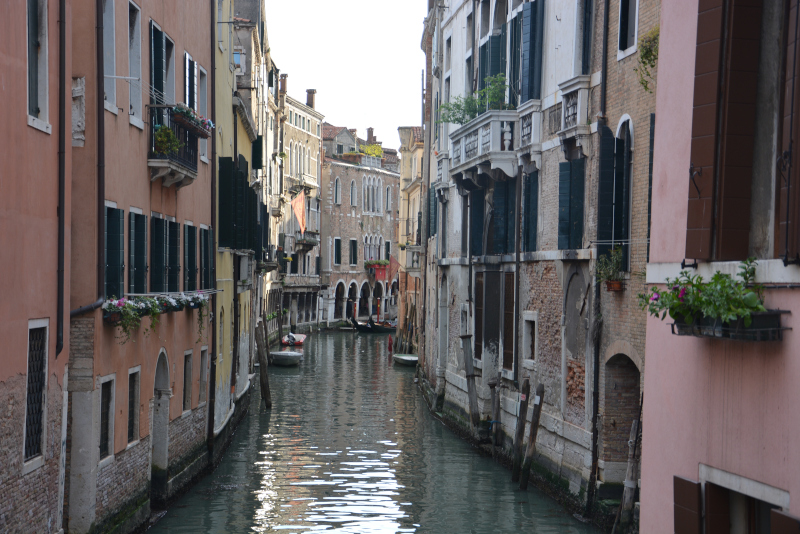
Parking facilities at the road access to Venice are very limited. It might be advantageous for you to look for accommodation in the nearby area with parking from which you can reach Venice itself by public transport. There are parking garages at Piazzale Roma, the last place accessible to road vehicles on the island of Venice, for about 30€ per day. In the offshore district of Mestre on the mainland, there are parking garages for about 14€/ until midnight. From there, a dense bus shuttle service runs city buses or regional trains to Venice’s Santa Lucia train station. Some hotels also offer parking in Mestre for a fee. More affordable are guarded long-term parking lots in the vicinity of the airport for from 5€ per day, although then the cost of the city bus or boat must be added.
Cruisers and Adriatic ferries to Venice
In addition, (still) all sorts of cruise ship companies operating in the Mediterranean head directly for the lagoon in Venice, sailing practically almost above the Marcus Square and immersing the city visitors in their soot flags. After an accident in May 2019 and a near-accident in early July of the same year, this issue is discussed all the more heatedly, but whether there will soon be a decision against cruise ships in the lagoon is not yet foreseeable. At the resumption of cruise – traffic to Corona in early June 2021, there were fierce protests from residents and lagoon protectors. It is grotesque – the cruise – tourists enthusiastically go to a city to whose demise they contribute.
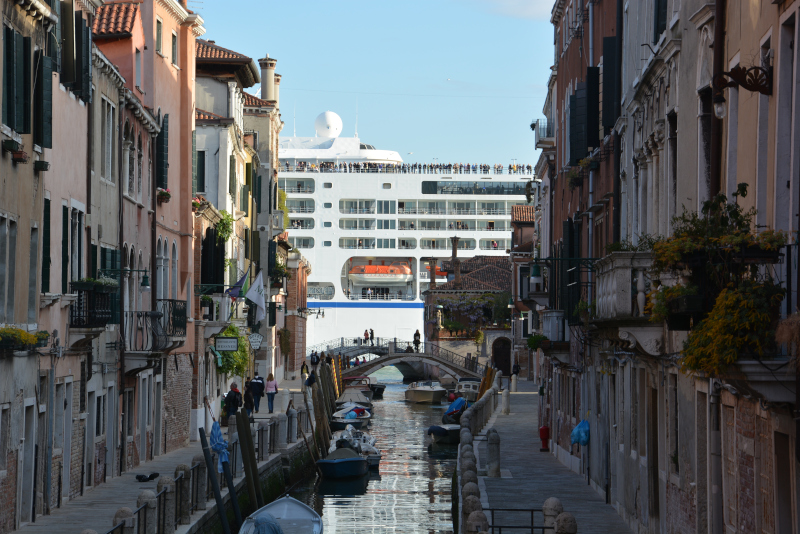
You can use regular ferries to Venice if you come from another region of the Adriatic. Then it is worth to look for it. The Adriatic ferries head for the ferry port in the Marghera district.
Weather and best travel times for Venice
Venice is certainly always a worthwhile destination. However, it is most beautiful when the weather cooperates. Therefore, the period from April to June as well as September and October is recommended. In March you have to reckon with rain or cold spells even in Venice, which can happen rather rarely in April.
In the summer months of July and August, the weather in Venice is certainly also often beautiful, but very hot for „Northern Alps“ – and you have to expect crowds of visitors who clog the narrow streets and bridges. If you have the choice, use the best spring! In Venice, the „city of lovers“ anyway the most beautiful time…
Regardless of the weather, the time of the Carnival in Venice is of course an eventful time. However, at the same time one with the biggest seasonal surcharges on accommodation and all other costs.
Staying in Venice – accommodations on and above the lagoon
Venice is a top tourist destination and accordingly there are rooms without end. But the great demand and popularity also ensures an upscale price. In the lagoon city – at least in the season – even budget accommodation with a bed in a dormitory can only be found from 35€ upwards. To the top…. is probably almost everything possible. And season is not only summer – Venetian Carnival is natural season as well, plus possibly times with special event highlights like Venice movie festival….
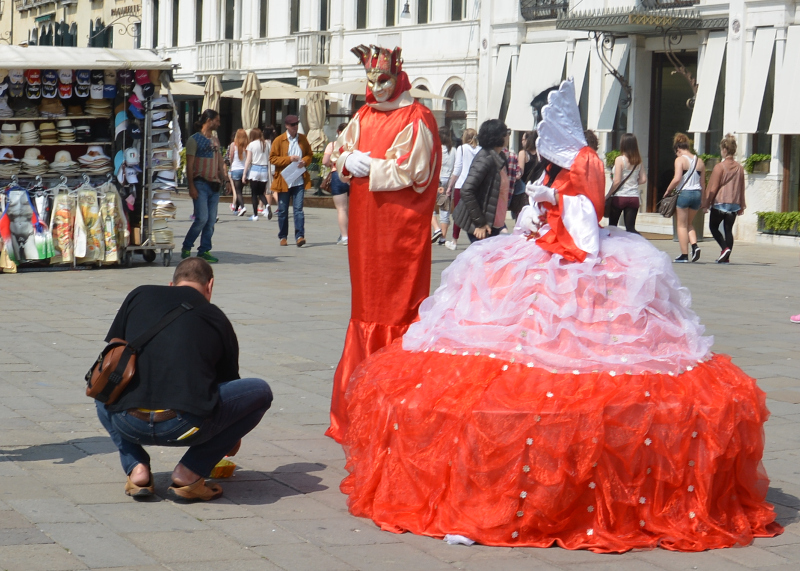
If you don’t necessarily want to spend the nights in the island city, Venice’s Mestre or Marghera districts offer some cheaper accommodations, sometimes with parking, that are well connected to the main island by city buses. Even getting there is cheaper, as much of the long-distance traffic off the lagoon is handled on the mainland. However, from July 2020, the levy for day tourists (see above) could put the cheaper accommodation costs at least partly into perspective again, especially for families with several travelers.
There are more hotels for the Venice – trip on the north-east located headland Lido di Jesolo (especially interesting for car travel). From this offshore peninsula on the Adriatic Sea vaporetto line boats go to the lagoon city parts. Accommodation on Lido di Jesolo could be favorable for families, especially since long beaches on the sea side invite for bathing and playing. Thus, city exploration in Venice can be combined with a beach vacation on the Adriatic Sea. There are also hotels on the Lido de Venezia. The Lido de Venezia is an island and therefore can only be reached by boat.
Important to know – in addition to the accommodation costs of the hotel, there is a tourism tax of the city of Venice, which must be charged extra by the hotels.
Venice Budget – Accommodation: hostels on the lagoon island
L’Imbarcadero, the hostel* closest to the Venice Santa Lucia train station. Get off, walk a few steps, check in! And then discover Venice… Colorful rooms for small groups, families, dorm beds, luggage storage. Vaporetti depart virtually from the front door.
Hostel Archie’s House* is located in the northern district of Cannaregio. It’s about 700m to Venice Santa Lucia train station on the same side of the Grand Canal. Rooms range from double rooms to dorm beds. Each bed comes with a locker. Shared kitchen and shared bathrooms
The Generator Venice Hostel* also has a variety of rooms from „deluxe king“ twin beds to 4-bed and family rooms to beds in dorms. Generator Venice Hostel is located in the southern island district of Giudecca and can only be reached by vaporetti (line 2, 4.1 or 4.2), water cab or other boats. The facility is handicapped accessible and wheelchair accessible.
Hostel Combo Venezia* is located in the Cannaregio district in an old convent building with a secluded courtyard. This hostel is also wheelchair accessible for the disabled. A vaporetto runs about 100m away. Twin rooms, apartments and dorm beds are available.
Good middle class hotels in the historic districts of Venice
Short distance to St. Mark’s Square: Locanda Casa Querini* In this hotel, double and triple rooms as well as a family room await interested visitors to Venice. A high-quality room equipment lets the stay become the pleasure. Breakfast is served either in the room or in a small breakfast room. On hot Italian nights the air conditioning helps.
Almost on the Rialto Bridge, the air-conditioned rooms of the Centauro Hotel* await guests. The house shines in the traditional Venetian style of the 18th century. Breakfast is served in a small dining room.
Hotel Marconi* is in Venice’s San Polo district, across from San Marco and connected to it by the nearby Rialto Bridge. Rooms, from single to four-bed, are furnished with stylish antique furnishings. Several Venetian markets are in the immediate vicinity. Breakfast is served in the dining room, small drinks also at tables in front of the hotel.
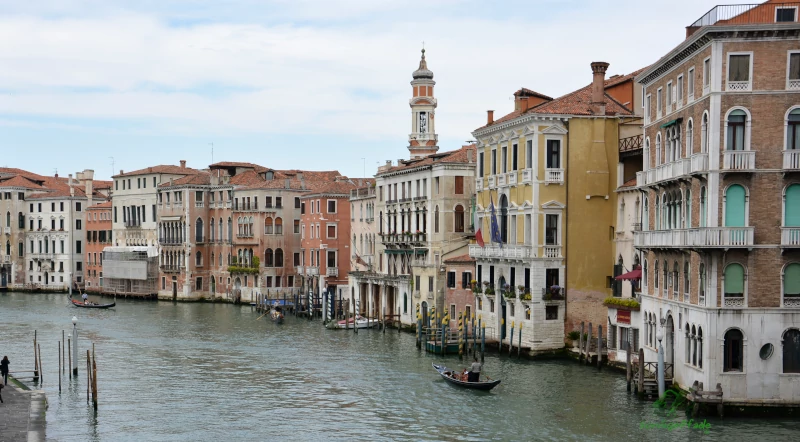
Luxury Venetian Rooms* make your stay in Venice a day and night experience. The rooms are located in an old building from the 14th century. The location is ideal – to the Rialto Bridge it is a 5 min walk, to the Marcus Square about 200m. All rooms have coffee/tea facilities.
The family-run Hotel Fontana* is located in the Castello district. It is only a few minutes‘ walk to Marcus- Square. Other Venice attractions are easily reached by vaporetto. Family rooms are also available, and childcare can even be arranged for a fee if needed. When feet are tired of pavement, a terrace invites guests to linger.
The Riva del Vin Boutique Hotel* is just 100 yards from the Rialto Bridge. A hearty breakfast and well-appointed rooms are popular with guests. Access is barrier-free and wheelchair-friendly. Coffee and tea accessories are available in the rooms.
Accommodation in Venice Mestre – hotels partly with parking offer
Here are some hotels or apartment – offers in Venice – Mestre, so on the mainland. Some of the accommodations offer parking, for which extra – costs may apply. Travel to the historic center of the lagoon city of Venice can be made from Mestre train station by regional trains or by city buses to Piazzale Roma.
Hotel Trieste* offers double and triple rooms with extra beds if necessary, as well as parking on the premises. (additional cost 15€/d). It is only a few steps to the Venice Mestre train and bus station. So you can reach the old town of Venice in 15min. Pets are allowed in this house on request.
Ca‘ Popolo Venice* has no parking facilities, but two-bed, three-bed and family rooms with private bathrooms. A shared kitchen is available for all guests. It is about 400m walk to the train station. Pets are not allowed here.
Unaway Eco Hotel Villa Constanza Venezia* has best reviews from a large number of guests. Secured parking in the courtyard is available for 14€/d. There are even charging facilities for electric cars. Room sizes from one to four beds ensure a perfect fit. A terrace can be used to relax after strenuous city exploration. The Venice – Mestre train station is 250m away. Baby/child care is available in the house for a fee. Part of the house is handicapped and wheelchair accessible also with voice-activated aids.
Quietly located in a residential area, Hotel Aaron* is about 200m from Venice Mestre train station. It has one to four bed rooms with bath or shower bath. Access is partially wheelchair accessible. Coffee/tea facilities are available in all rooms. Pets are allowed. Parking is not offered here.
Luxury hotels in Venice – „In the footsteps of the Doges and merchants“
Luxury accommodation in the center of Venice: Of course, in a city like Venice you will find princely luxury hotels that combine the splendor of past times with modern service. Here dreams come true, here you can indulge in the wealth of the former Adriatic republic.
One of the sophisticated hostels is Hotel***** Londra Palace*, overlooking St. Mark’s Basin and just a 5-minute walk from St. Mark’s Square. Each of the stylishly furnished rooms has its own character, with silk fabrics and paintings on the walls. For the guests, not only the culture and history of the city become vivid, but from morning to night, a delicate bond with history becomes palpable.
On the Grand Canal, overlooking the church of Santa Maria delle Salute, the Gritti Palace***** Hotel* invites guests to spend romantic nights, built in an old noble residence. Rooms are furnished with antiques and include Murano glass artwork. Fresh ingredients are sourced from the Rialto market for the restaurant’s delicacies. For those who want to top off their stay with impressive culture, La Fenice Opera House is 5 minutes away.
Also on the Grand Canal is the St. Regis***** Venice*. The outstanding view of the canal is enhanced by the panoramic restaurant and bar, creating an ambience of true Venice culinary delights. Rooms feature sophisticated designer furnishings. Bathrooms are finished in marble. In the surrounding area there are many popular stores, cafes and restaurants. It is a 5-minute walk to the church of St.Marco.
Baglioni***** Hotel Luna* carries the distinguished address of San Marco not only as a district, but also in its placement. In the rooms, in addition to precious fabrics and furniture, chandeliers made of Murano glass and tastefully marbled bathrooms are characteristic. Many walls, including those in the restaurant, are decorated with frescoes. From the roof terraces you can enjoy the view of St.Marco, and over the lagoon by day and by night. The vaporetto stop San Marco- Vallaresso is just a few steps away, but the hotel has its own dock.
Public transport in Venice – by boat, bus and train in the lagoon
The lagoon city of Venice is preceded by the district of Mestre on the mainland. This can be interesting both in terms of accommodation and for travel. All trains to the island’s main train station, Venice Santa Lucia, go via Mestre (about 1€ on the regional train). Mestre is the hub for arrival and departure and there is a very dense regional train connection to the lagoon island. In addition, the city bus services of Actv (the Venice Public Transport Company) run from Mestre or Marghera to Venice via Ponte della Libera – as far as the bus service into the lagoon is allowed. This is the case up to Piazzale Roma. From there, everything is only by foot or by boat – regular public boats „vaporetti“, water cabs, gondolas….
Venice’s vaporetti transport – almost everything by boat
The boat connections with the vaporetti are very developed, just like the city bus lines in other cities. Boats run every 5-10 minutes on the main lines of the Grand Canal or Canal della Giudecca. Side lines are served less frequently, but still sufficiently. You can download the current line plans of the Vaporetti here as a .pdf file for better planning.

Everything goes in a jiffy: you check which line is heading for your destination and look for the right boat at the pier. The boat is moored for a short time, the passengers get off, the passengers get on and off you go.
Take care of your luggage! Put down your backpacks or at least take them to the front! First, you can get stuck somewhere or push other passengers unintentionally through the area and secondly, you risk theft, which is particularly easy in the crowds on the vaporetti. At the validator briefly hold the card until it beeps, everything is clear. The next stations are announced. With a small city map/line map the system can be seen through fast, so that you will have hardly orientation difficulties. Getting lost is not really possible…. You are traveling on an island. If you want an app for the ACTV local transport in Venice, you can use the AVM app to find the next connection and pay by credit card.
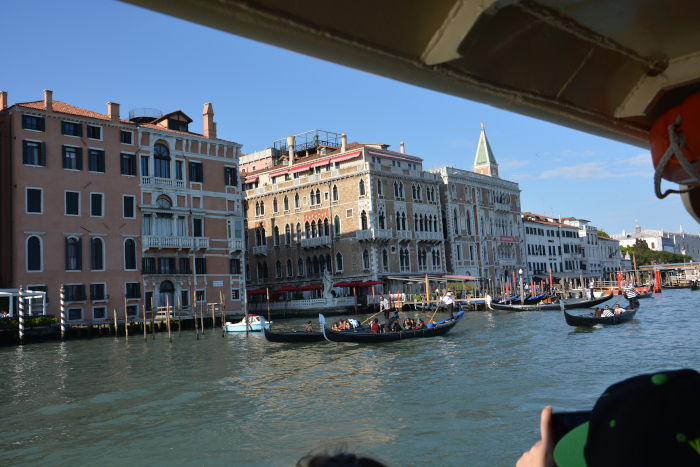
Worthwhile day and multi-day tickets for Venice
Depending on the duration of your stay, the daily or multi-day ticket of actv for local transport in Venice is worthwhile (e.g. 24h=20€, 48h = 30€,. 7days = 60€, as of 2021). For young people up to 29 years, there is the 3-day ticket for the special price of 22€. Even if you will explore and discover a lot on foot – in the narrow streets, many bridges and squares lies the charm of Venice – it is always nice, relaxing and useful for „gaps“ to change in between on a boat.
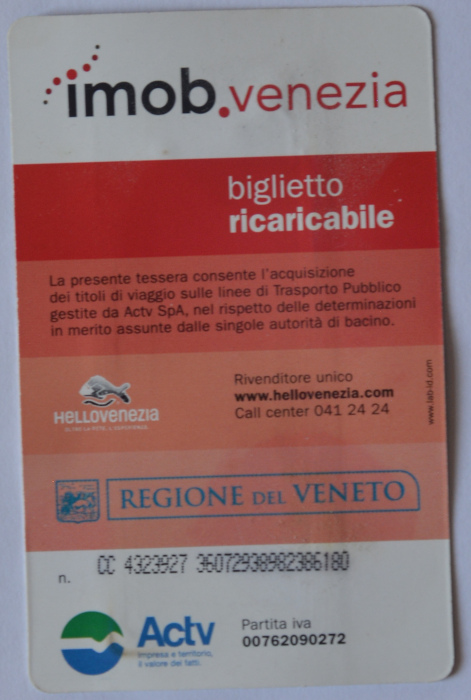
In addition, you can use the actv multi-day ticket, for example, to Mestre in your quarters or with the vaporetti to islands such as the glass art district Murano or Lido (beach). The tickets are chipped (RFID technology) and must be held up to the validator when boarding until it beeps. This unlocks the use of the line (and validates it accordingly for single tickets). The connection to the airport, however, has different rates and must be booked separately – e.g. with the bus driver.
If your accommodation is in the lagoon anyway and you are on foot, one of the (for tourists expensive) one-way tickets is enough.
Info, prices and schedules : http://actv.avmspa.it/en
Gondola rides in Venice
Gondolas are an upscale pleasure – from 80€ upwards for half an hour you have to reckon, whereby the price can be distributed to a maximum of 6 passengers.
You can get a „short gondola ride“ for around 2€ if you use one of the gondola ferries (traghetti) across the Grand Canal. The Traghetti connect Venice’s districts of San Marco with San Polo or Dorsodure and Canaregio with Santa Croce. However, this trip takes only a few minutes and was often spent standing in the past. Due to the sharp increase in boat traffic and the associated wave action, the water of the Grand Canal is now so choppy that even the locals usually sit down.
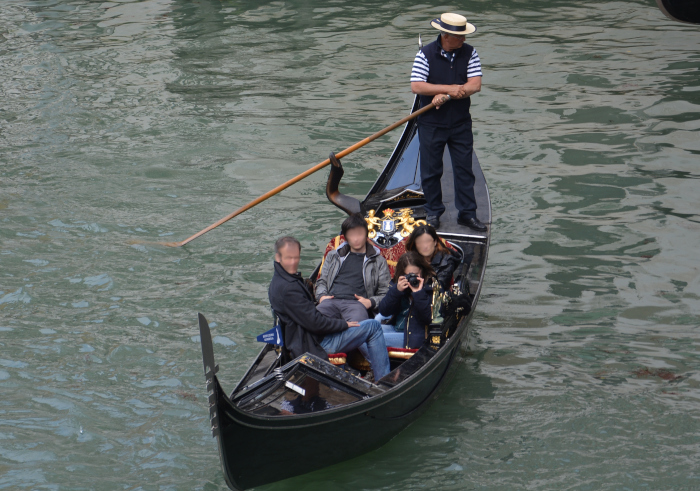
Money in Italy
In Italy – so also in Venice – the Euro is valid. Since ATMs in the lagoon city are often taught by the crowds of tourists in a short time, it is worthwhile to pocket enough cash beforehand on the mainland. If you like, you can of course also pay almost everywhere with credit card. As always in tourist strongholds, make sure that your valuables are safely stored!
Venice books – Map, Travel guide etc.
City map and mini guide Venice
For your best overview in Venice you can take the city map*. It is a folded sheet map with waterresistant and rip-proof paper for the plan. Additional you get a small guide book with informations about transport, tourist service, ticketing information and a plan for public transport.
Venice and the Veneto
You will stay a little longer in the Veneto region? These guide book is not restricted to Venice city. In the Venice and Veneto Guide* you get a lot of information about the whole region around Venice including Verona and the Dolomites with detailed maps and easy-to-follow itineraries.
Venice City of Art
The hardcover book Venice City of Art* gives you a lot of photographic impressions through the centuries. Not only famous places around San Marco, little alleys and narrow canal ways and hidden places. The text offers you an introduction of the builders and the cititzens, the power of the Doges and a lot of stories from the lagoon city.
As a summary here a little FAQ Venice:
Venice is a European city in northeastern Italy on the northern coast of the Adriatic Sea. Venice is located in the Laguna di Venezia.
A lagoon is an area of brackish water partially separated from the sea by a spit or reef. The Venice lagoon is separated from the Adriatic Sea by headlands and a chain of islands. The atolls in the South Pacific are islands surrounded by a ring reef, the lagoon is then located between the ring reef and the island.
Venice was founded as early as the 8th and 9th centuries on islands in a lagoon on the northern shore of the Adriatic Sea. The inhabitants used the strategic advantage of the island location and their skills in boat building and trade as well as the possibilities in a border region between Orient and Occident as successful long-distance traders, whereby the rich city continued to grow. To this end, the islands were artificially expanded and developed. However, the neglect of the maintenance of the canals and the expansion of the lagoon – entrances in the course of industrialization in the 19th and 20th centuries led to Venice being hit harder by floods and the violence of water in general.
A gondola ride costs from 80€ / half hour, and up to 6 people can share this price. A „taster – gondola ride“ is possible for a few euros at several points on the Grand Canal, where the gondolas cross as a ferry.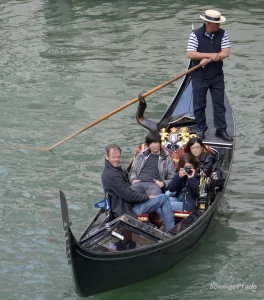
About 400. This is a bit question of definition – what is bridge, what is just footbridge. The maximum counts assume 435 bridges.
Standards for a Venice visit are Rialto Bridge over the Grand Canal, St. Mark’s Square with St. Mark’s Basilica and bell tower „Campanile“, Doge’s Palace and Bridge of Sighs. In addition, however, there is an incredible variety of cultural monuments, museums, churches and palaces. A visit to the glassblower – island Murano or the island of San Giorgio Maggiore with the church of the same name (Best view from the tower on St. Mark’s Square!) or the Jewish quarter in the district Cannaregio is recommended.
Invite friends to Venice? Share the link!
If the travel tips for Venice have helped you and you now feel like a trip to the lagoon city, then tell your friends! The best way is to share the link on your social media channels. Thank you!
* Note about affiliate links
The links marked with * lead to provider sites, from which I receive a commission on purchases and deals. There are no additional costs for you, because the commission is already included in the offered prices.
Image source: Product images – manufacturer / dealer



